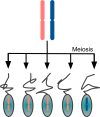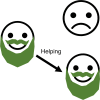Selfish genetic elements
- PMID: 30439939
- PMCID: PMC6237296
- DOI: 10.1371/journal.pgen.1007700
Selfish genetic elements
Abstract
Selfish genetic elements (historically also referred to as selfish genes, ultra-selfish genes, selfish DNA, parasitic DNA, genomic outlaws) are genetic segments that can enhance their own transmission at the expense of other genes in the genome, even if this has no or a negative effect on organismal fitness. [1-6] Genomes have traditionally been viewed as cohesive units, with genes acting together to improve the fitness of the organism. However, when genes have some control over their own transmission, the rules can change, and so just like all social groups, genomes are vulnerable to selfish behaviour by their parts. Early observations of selfish genetic elements were made almost a century ago, but the topic did not get widespread attention until several decades later. Inspired by the gene-centred views of evolution popularized by George Williams[7] and Richard Dawkins,[8] two papers were published back-to-back in Nature in 1980-by Leslie Orgel and Francis Crick[9] and Ford Doolittle and Carmen Sapienza[10] respectively-introducing the concept of selfish genetic elements (at the time called "selfish DNA") to the wider scientific community. Both papers emphasized that genes can spread in a population regardless of their effect on organismal fitness as long as they have a transmission advantage. Selfish genetic elements have now been described in most groups of organisms, and they demonstrate a remarkable diversity in the ways by which they promote their own transmission.[11] Though long dismissed as genetic curiosities, with little relevance for evolution, they are now recognized to affect a wide swath of biological processes, ranging from genome size and architecture to speciation.[12].
Conflict of interest statement
The authors have declared that no competing interests exist.
Figures







References
-
- Werren JH, Nur U, Wu CI. Selfish genetic elements. Trends Ecol Evol. 1988;3: 297–302. 10.1016/0169-5347(88)90105-X - DOI - PubMed
-
- Hurst GD, Hurst LD, Johnstone RA. Intranuclear conflict and its role in evolution. Trends Ecol Evol. 1992;7: 373–378. 10.1016/0169-5347(92)90007-X - DOI - PubMed
-
- Hurst LD, Atlan A, Bengtsson BO. Genetic conflicts. Q Rev Biol. 1996;71: 317–364. - PubMed
-
- Hurst GD, Werren JH. The role of selfish genetic elements in eukaryotic evolution. Nat Rev Genet. 2001;2: 597–606. 10.1038/35084545 - DOI - PubMed
-
- McLaughlin RN Jr, Malik HS. Genetic conflicts: the usual suspects and beyond. J Exp Biol. 2017;220: 6–17. 10.1242/jeb.148148 - DOI - PMC - PubMed
Publication types
MeSH terms
Grants and funding
LinkOut - more resources
Full Text Sources
Research Materials

